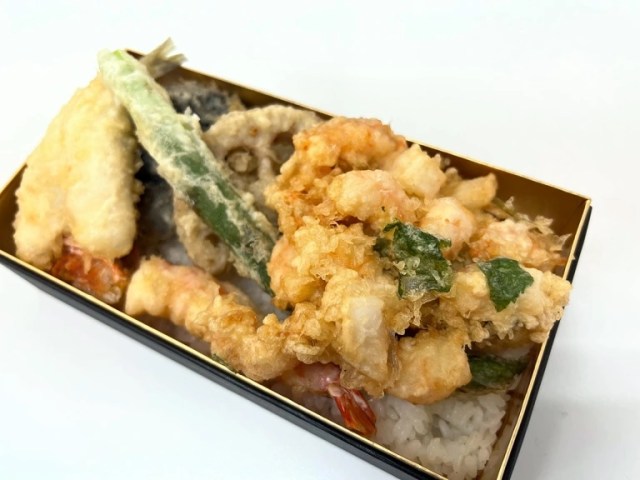
A bento from a fast food joint versus one from a luxury hotel.
Fried food often gets saddled with the image of being cheap, greasy eats, but tempura is an exception. In classical Japanese cuisine, it’s considered quite the delicacy, and a meal at a high-end tempura restaurant can run just as much as you’d pay at a sushi or sukiyaki specialist.
That said, you can find affordable tempura in Japan too, often for a fraction of a price of the more expensive stuff. For example, fast food chain Tenya serves up a perfectly tasty Tendon Bento (tempura and rice boxed lunch) for just 500 yen (US$4.35).
▼ A Tenya branch
▼ Tenya’s Tendon Bento
Meanwhile, on our last trip to swanky department store Isetan in Tokyo’s Shinjuku neighborhood, we came across a tempura boxed lunch made by Yama no Ue, a Tokyo luxury hotel with its own tempura restaurant, priced at 3,780 yen (US$32.90).
▼ The Yama no Ue Tokusei Tenju (Special-grade Tempura and Rice)
So basically for the same price as just one expensive tempura lunch, you could eat the less-expensive one every day for an entire week, plus still have some change left over to put towards some sakura sweets for dessert. Curious to see what, if any, difference there actually is between the two other than price, our Japanese-language reporter Yuichiro Wasai decided to buy both and find out for himself.
Let’s start with the visual comparison. Pictured on the left is the expensive Yama no Ue tempura, and on the right is Tenya’s much, much cheaper one.
You’re probably thinking the presentation looks a little nicer for the Yama no Ue lunch, but that’s actually Yuichiro’s doing. Yaman no Ue’s tempura bento comes in a two-layered box, with the tempura in one section and the rice in another, and the above photo is how it looked after Yuichiro himself transferred the tempura to the rice.
▼ Here’s how it looked when he first opened the box.
Some people might think having to transfer the tempura themselves is a pain, but it also makes it easier to heat everything up if it’s gotten lukewarm on your way home, since the tempura and rice have different optimal procedures (Yama no Ue recommends warming the tempura itself in a toaster oven, and the rice in a microwave). Yama no Ue keeping the rice and tempura separate is also a plus since they give you a container of tsuyu (tempura sauce) to add to taste right before you start eating, whereas Tenya pours it on before giving you your food, which can make it a little soggy if a long time passes between purchasing and eating.
▼ Yama no Ue’s tsuyu
As for what exactly you get in each bento, there’s some overlap, with both giving you a shrimp and slice of whitefish.
▼ Yama no Ue (left) and Tenya (right) shrimp
The actual size of the shrimp was surprisingly similar. The Yama no Ue one, though, is straighter and its breading smoother. In contrast, Tenya’s shrimp had curled slightly during cooking, and there’s more bubbling in the tempura coating. Which looks nicer is really a matter of personal aesthetic taste, and the differences don’t really affect the flavor. However, when Yuichiro bit into them, he found the Yama no Ue tempura started with a firm outer layer to the shrimp that gave way to an immensely pleasing, moist snap at its core, making it the much more satisfying texture.
Things were similar with the whitefish. Their sizes were about the same, but Yama no Ue’s had an extra nice airiness to how its breading had cooked up.
▼ Yama no Ue (left) and Tenya (right) whitefish
From here, the ingredients diverged. The other tempura players on Tenya’s team are squid, kabocha (Japanese pumpkin/squash), and green beans, all budget-conscious overachievers. Yama no Ue, though, goes with premium with shiitake mushroom.
▼ Yama no Ue’s shiitake
Yama no Ue also gives you renkon (lotus root), asparagus, and kakiage, a cluster of mixed tempura, with large pieces of sliced shrimp ad squid.
▼ Yama no Ue’s kakiage
So overall, which did Yuichiro think tasted better? “The Yama no Ue tempura, and it’s not even close,” he said with a satisfied smile and full stomach.
However, that’s not to say that the more expensive tempura bento is the better tempura bento. Yuichiro himself is quick to point out that he’s a big fan of Tenya’s super affordable tempura too, and if you, like us, aren’t in a position to splurge on 3,780-yen lunches every day, Tenya will take care of your finances and tempura cravings quite nicely.
But on special occasions, when you want a little edible luxury? Then Yuichiro thinks treating yourself to the more expensive tempura is money well spent.
Top image: SoraNews24
Insert images: Wikipedia/Lombroso, SoraNews24
● Want to hear about SoraNews24’s latest articles as soon as they’re published? Follow us on Facebook and Twitter!
[ Read in Japanese ]

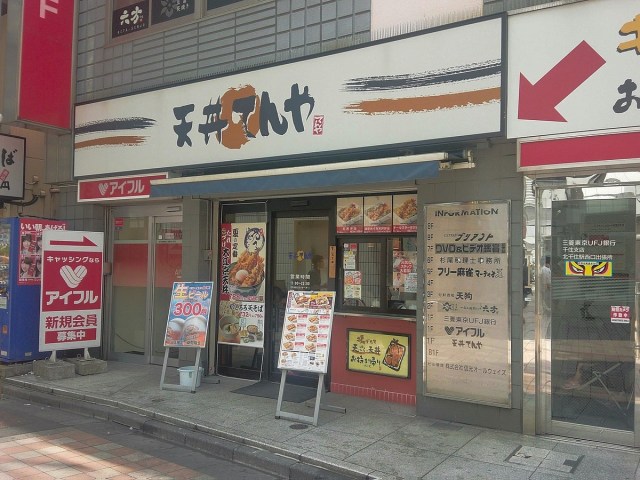
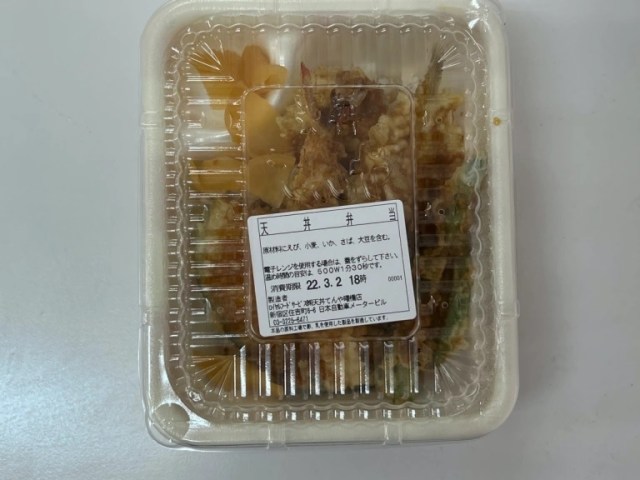
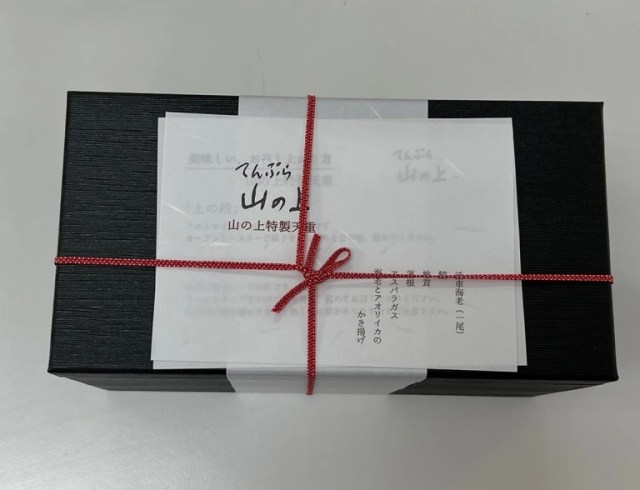
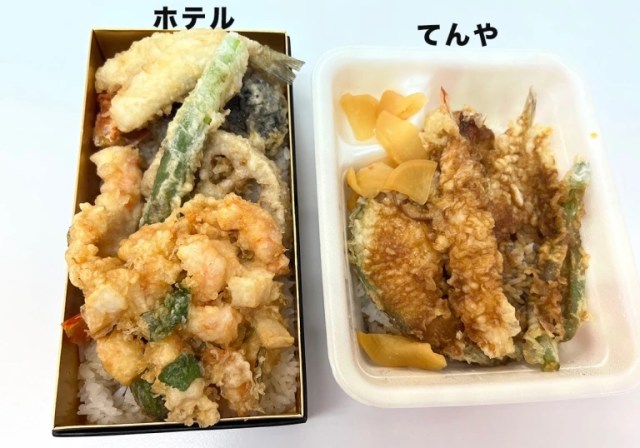
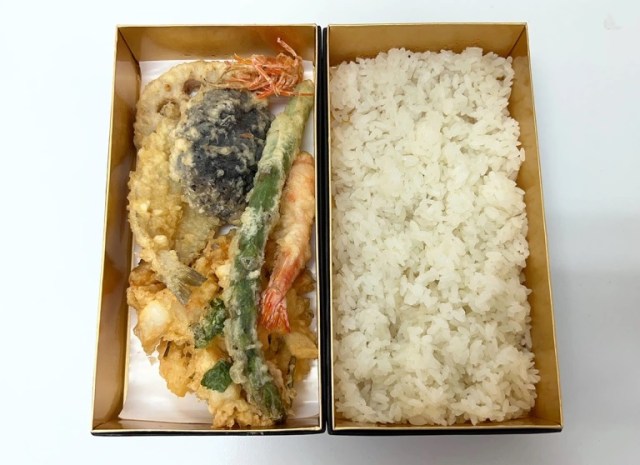
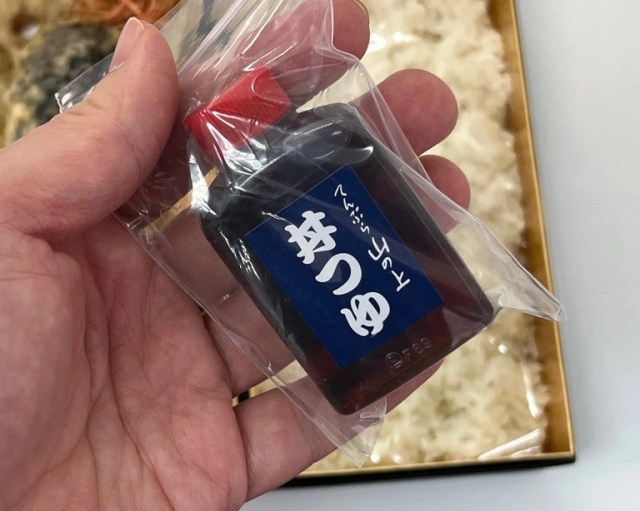
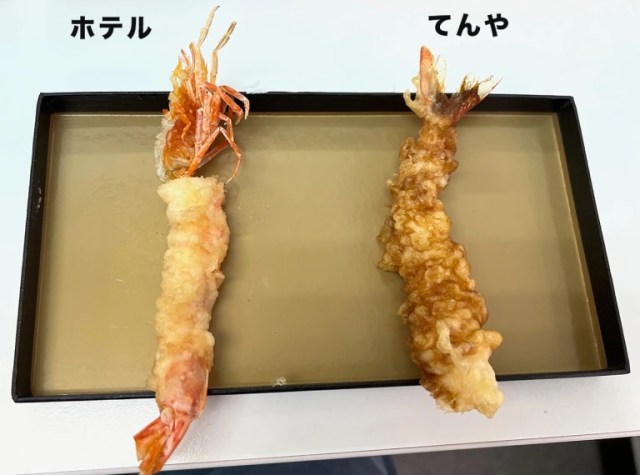
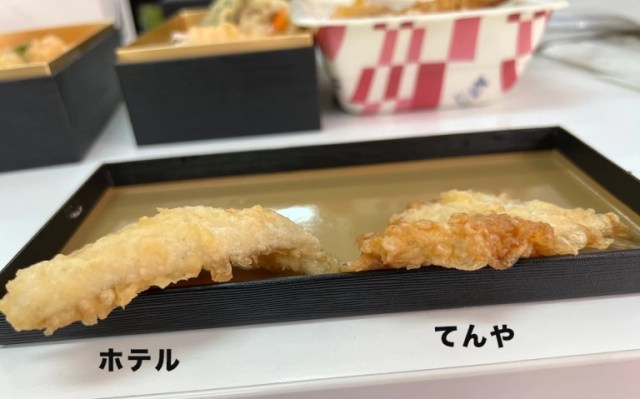
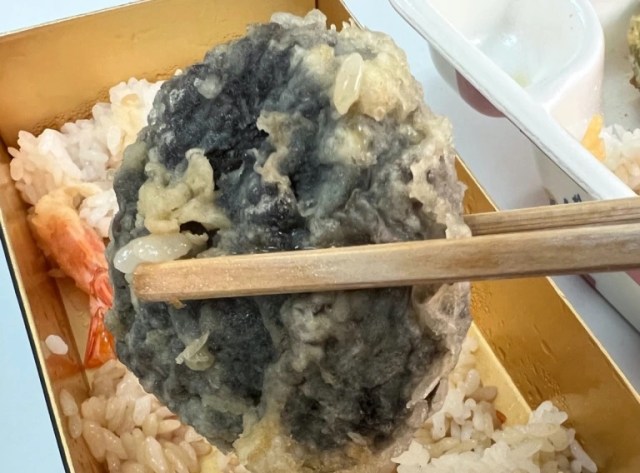
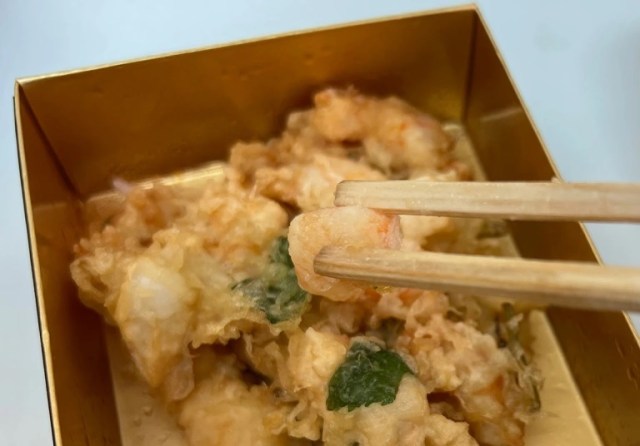
 Clam chowder tempura being offered by Japan’s most popular tempura restaurant chain
Clam chowder tempura being offered by Japan’s most popular tempura restaurant chain How to make a delicious tempura nothing bowl without any actual cooking【SoraKitchen】
How to make a delicious tempura nothing bowl without any actual cooking【SoraKitchen】 Udon chain’s awesome “Tempura Pass” deal works out to less than 10 yen per piece over five weeks
Udon chain’s awesome “Tempura Pass” deal works out to less than 10 yen per piece over five weeks Tokyo restaurant offers “DIY Tempura Bowls,” so of course we had to go check it out
Tokyo restaurant offers “DIY Tempura Bowls,” so of course we had to go check it out Japan’s one-person mini tempura pot turns every day into fry day
Japan’s one-person mini tempura pot turns every day into fry day How to order snacks on a Shinkansen bullet train in Japan
How to order snacks on a Shinkansen bullet train in Japan Demon Slayer: Kimetsu no Yaiba gets new roller coaster attractions and food at Universal Studios Japan
Demon Slayer: Kimetsu no Yaiba gets new roller coaster attractions and food at Universal Studios Japan New samurai glasses are Japan’s latest weird must-have souvenir
New samurai glasses are Japan’s latest weird must-have souvenir Burger King Japan suddenly adds Dr. Pepper and Dr. Pepper floats to its menu nationwide
Burger King Japan suddenly adds Dr. Pepper and Dr. Pepper floats to its menu nationwide Nintendo history you can feel – Super NES, N64, and GameCube controllers become capsule toys
Nintendo history you can feel – Super NES, N64, and GameCube controllers become capsule toys High-fashion Totoro cuddle purse is like an elegant stroll in the forest【Photos】
High-fashion Totoro cuddle purse is like an elegant stroll in the forest【Photos】 Japan’s new difficult-to-drink-from beer glass protects your liver, but it’s a brutal experience
Japan’s new difficult-to-drink-from beer glass protects your liver, but it’s a brutal experience Kyoto Tower mascot termination reveals dark side behind cute Japanese characters
Kyoto Tower mascot termination reveals dark side behind cute Japanese characters New Pokémon ice cream, dessert drinks, and cool merch coming to Baskin-Robbins Japan【Pics】
New Pokémon ice cream, dessert drinks, and cool merch coming to Baskin-Robbins Japan【Pics】 To combat declining birth rate, Japan to begin offering “Breeding Visas” to foreigners
To combat declining birth rate, Japan to begin offering “Breeding Visas” to foreigners Hello, cosmetics! Clinique teams up with Hello Kitty this summer for first-time collaboration
Hello, cosmetics! Clinique teams up with Hello Kitty this summer for first-time collaboration “The most Delicious Cup Noodle in history” – Japan’s French Cup Noodle wins our heart【Taste test】
“The most Delicious Cup Noodle in history” – Japan’s French Cup Noodle wins our heart【Taste test】 Starbucks releases a cute Frappuccino and Unicorn Cake…but not in Japan
Starbucks releases a cute Frappuccino and Unicorn Cake…but not in Japan McDonald’s Japan’s Soft Twist Tower: A phantom ice cream only sold at select branches
McDonald’s Japan’s Soft Twist Tower: A phantom ice cream only sold at select branches Yabai Ramen: What makes this Japanese ramen so dangerous?
Yabai Ramen: What makes this Japanese ramen so dangerous? Finally! Nintendo Japan expands Switch 8-bit controller sales to everybody, Online member or not
Finally! Nintendo Japan expands Switch 8-bit controller sales to everybody, Online member or not Japanese government wants to build luxury resorts in all national parks for foreign tourists
Japanese government wants to build luxury resorts in all national parks for foreign tourists 10 things you should buy at 7-Eleven in Japan
10 things you should buy at 7-Eleven in Japan Studio Ghibli releases anime heroine cosplay dresses that are super comfy to wear
Studio Ghibli releases anime heroine cosplay dresses that are super comfy to wear Woman charged for driving suitcase without a license in Osaka
Woman charged for driving suitcase without a license in Osaka Studio Ghibli unveils My Neighbour Totoro miniature house model
Studio Ghibli unveils My Neighbour Totoro miniature house model Kyoto experiencing problems with foreign tourists not paying for bus fares, but not on purpose
Kyoto experiencing problems with foreign tourists not paying for bus fares, but not on purpose Fighting mild hunger with a Japanese soda that turns into jelly in the stomach【Taste test】
Fighting mild hunger with a Japanese soda that turns into jelly in the stomach【Taste test】 Studio Ghibli’s Howl’s Moving Castle tapestry unveiled in Japan for first time
Studio Ghibli’s Howl’s Moving Castle tapestry unveiled in Japan for first time McDonald’s new Happy Meals offer up cute and practical Sanrio lifestyle goods
McDonald’s new Happy Meals offer up cute and practical Sanrio lifestyle goods Sales of Japan’s most convenient train ticket/shopping payment cards suspended indefinitely
Sales of Japan’s most convenient train ticket/shopping payment cards suspended indefinitely Sold-out Studio Ghibli desktop humidifiers are back so Totoro can help you through the dry season
Sold-out Studio Ghibli desktop humidifiers are back so Totoro can help you through the dry season Japanese government to make first change to romanization spelling rules since the 1950s
Japanese government to make first change to romanization spelling rules since the 1950s Foreigner’s request for help in Tokyo makes us sad for the state of society
Foreigner’s request for help in Tokyo makes us sad for the state of society Ghibli founders Toshio Suzuki and Hayao Miyazaki contribute to Japanese whisky Totoro label design
Ghibli founders Toshio Suzuki and Hayao Miyazaki contribute to Japanese whisky Totoro label design Doraemon found buried at sea as scene from 1993 anime becomes real life【Photos】
Doraemon found buried at sea as scene from 1993 anime becomes real life【Photos】 Tokyo’s most famous Starbucks is closed
Tokyo’s most famous Starbucks is closed Princesses, fruits, and blacksmiths: Study reveals the 30 most unusual family names in Japan
Princesses, fruits, and blacksmiths: Study reveals the 30 most unusual family names in Japan No one asked but we did it anyways: MOS rice patty burgers X ochazuke【Taste test】
No one asked but we did it anyways: MOS rice patty burgers X ochazuke【Taste test】 Is Denny’s Japan’s new ultra-expensive Amaou strawberry parfait worth it?【Taste test】
Is Denny’s Japan’s new ultra-expensive Amaou strawberry parfait worth it?【Taste test】 Limited-edition Carbonara Udon will anger noodle purists and pasta lovers 【Taste test】
Limited-edition Carbonara Udon will anger noodle purists and pasta lovers 【Taste test】 Our reporter investigates the strangely named “shaved ice donburi” at a Tokyo cafe
Our reporter investigates the strangely named “shaved ice donburi” at a Tokyo cafe Meet the Mega Bento, a Japanese meal that’s heavier than a newborn baby
Meet the Mega Bento, a Japanese meal that’s heavier than a newborn baby 7-Eleven’s new Ebiten tempura shrimp rice ball is premium in both taste AND cost
7-Eleven’s new Ebiten tempura shrimp rice ball is premium in both taste AND cost Think you’ve had every type of tempura? Not until you’ve eaten deep-fried maple leaves
Think you’ve had every type of tempura? Not until you’ve eaten deep-fried maple leaves Move aside hot dogs, the Tempura Udon Dog is here, and it’s amazing
Move aside hot dogs, the Tempura Udon Dog is here, and it’s amazing Which Japanese conveyor belt sushi chain has the best Prawn Tempura Sushi?【Taste test】
Which Japanese conveyor belt sushi chain has the best Prawn Tempura Sushi?【Taste test】 How to turn leftover tempura into fried rice (or why to buy all the takeout tempura you can)
How to turn leftover tempura into fried rice (or why to buy all the takeout tempura you can) How to have a great meal at conveyer belt sushi chain Kura Sushi even if you hate raw fish
How to have a great meal at conveyer belt sushi chain Kura Sushi even if you hate raw fish This Kobe Beef croquette currently has a 35-year waitlist…So is it worth it?【Taste Test】
This Kobe Beef croquette currently has a 35-year waitlist…So is it worth it?【Taste Test】 Tokyo’s new solo-customer-only cafe is an all-inclusive, view-filled paradise for party of one
Tokyo’s new solo-customer-only cafe is an all-inclusive, view-filled paradise for party of one Why stay at a hotel in Japan when you can rent this entire mountain instead?【Photos】
Why stay at a hotel in Japan when you can rent this entire mountain instead?【Photos】 It turns out deep frying grilled rice balls makes them amazingly delicious【SoraKitchen】
It turns out deep frying grilled rice balls makes them amazingly delicious【SoraKitchen】 Four things you should order at rotating sushi restaurant Sushiro if you don’t eat raw fish
Four things you should order at rotating sushi restaurant Sushiro if you don’t eat raw fish
Leave a Reply